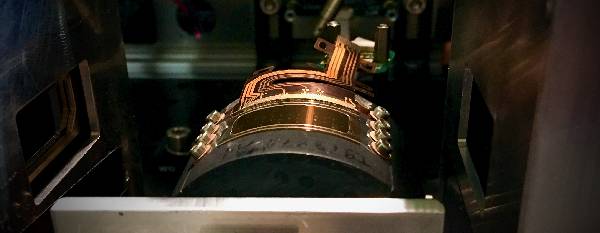
In high-energy physics experiments, tracking is the ability to reconstruct the trajectory followed by all the particles produced in the collision under investigation. Silicon based sensors are often the best choice for the design of the tracking layers closest to the interaction point.
For example, this is true in the four main detectors collecting data at the LHC particle accelerator facilities.
In view of the upcoming (Run 3, starting from 2022) and future (Run 4, starting from 2027) LHC colliding program, all the experiments and the accelerator itself completed or are working for the improvement of their components. Specifically, CMS and ALICE Collaborations foresee a major upgrade of their silicon tracking systems.
Researchers and technicians in Bari INFN team are strongly involved in the design, prototyping, construction and characterisation of these new highly innovative detectors.
The CMS experiment will completely replace the existing tracking system, in order to cope with the higher collision rate that will be provided by the LHC during Run 4.
The new detector can be schematically divided in two parts implementing different silicon sensor technologies: the inner and the outer tracker. The CMS Bari group is contributing, in different ways, to both of them. A large effort is spent in the design and characterisation of the pixel sensor for the inner tracker.
This new sensor must work with high efficiency in a tracks highly dense ambient. It will be an hybrid detector whose final cell geometry and sensor type are still open, with two main options: planar or the new 3D technology. CMS outer tracker will cover a very large area (25 m2) and will implement multiple sensor technologies.
The most striking characteristic of the outer tracker module is the ability to distinguish on-the-fly the velocity of the crossing particle allowing data taking at very high rate (trigger capability). Such a goal requires stringent constraints on the alignment precision of the module components, like the two embedded sensors, and a readout electronics that allows a synchronous reading.
CMS Bari group is contributing in the definition of the module assembly workflow and foresees the actual assembly and characterisation of 1000 modules.
While completing the installation and commissioning of the new inner tracker that will take data during Run 3, the ALICE Collaboration is already working for a further upgrade to be completed before Run 4.
Focus of the ALICE physics program is the identification of heavy particles containing charm or beauty quarks down to very low velocity. This requires very high tracking capabilities, granted through high sensor granularity, small distance to the interaction point and small material for services or support structures in front of the sensible area.
The ALICE Bari group is involved in the ITS3 project that aims to design and assembly the highly innovative first truly cylindrical inner tracker. This requires the development of a wafer-scale dimension monolithic sensor to be bent in a cylindrical shape and kept in position with light carbon foam support structures.
Local team is involved in the characterisation of bent silicon sensors, the development of mechanical tools for silicon sensor bending and wire-bonding and the design of flex for powering and communication. Such kind of developments represent also the proof of principle for trackers of future experiments, like the one at the Electron Ion Collider and the proposed future of the ALICE experiment after Run 4.
Relatore: Domenico Colella
Data: 03/02/2022
